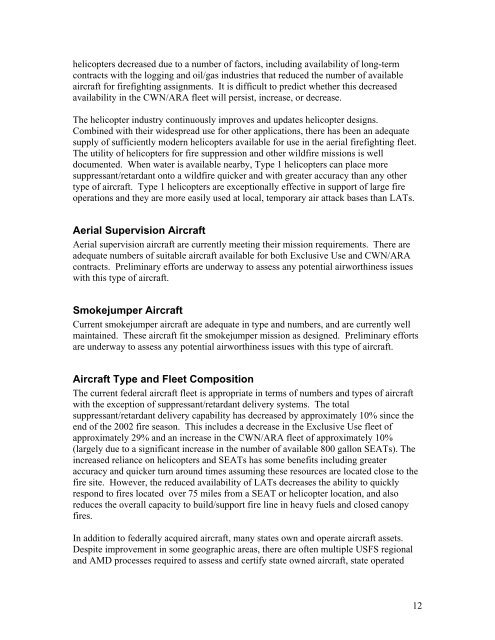Interagency Aviation Strategy - July 2008 - National Wildfire ...
Interagency Aviation Strategy - July 2008 - National Wildfire ...
Interagency Aviation Strategy - July 2008 - National Wildfire ...
Create successful ePaper yourself
Turn your PDF publications into a flip-book with our unique Google optimized e-Paper software.
helicopters decreased due to a number of factors, including availability of long-term<br />
contracts with the logging and oil/gas industries that reduced the number of available<br />
aircraft for firefighting assignments. It is difficult to predict whether this decreased<br />
availability in the CWN/ARA fleet will persist, increase, or decrease.<br />
The helicopter industry continuously improves and updates helicopter designs.<br />
Combined with their widespread use for other applications, there has been an adequate<br />
supply of sufficiently modern helicopters available for use in the aerial firefighting fleet.<br />
The utility of helicopters for fire suppression and other wildfire missions is well<br />
documented. When water is available nearby, Type 1 helicopters can place more<br />
suppressant/retardant onto a wildfire quicker and with greater accuracy than any other<br />
type of aircraft. Type 1 helicopters are exceptionally effective in support of large fire<br />
operations and they are more easily used at local, temporary air attack bases than LATs.<br />
Aerial Supervision Aircraft<br />
Aerial supervision aircraft are currently meeting their mission requirements. There are<br />
adequate numbers of suitable aircraft available for both Exclusive Use and CWN/ARA<br />
contracts. Preliminary efforts are underway to assess any potential airworthiness issues<br />
with this type of aircraft.<br />
Smokejumper Aircraft<br />
Current smokejumper aircraft are adequate in type and numbers, and are currently well<br />
maintained. These aircraft fit the smokejumper mission as designed. Preliminary efforts<br />
are underway to assess any potential airworthiness issues with this type of aircraft.<br />
Aircraft Type and Fleet Composition<br />
The current federal aircraft fleet is appropriate in terms of numbers and types of aircraft<br />
with the exception of suppressant/retardant delivery systems. The total<br />
suppressant/retardant delivery capability has decreased by approximately 10% since the<br />
end of the 2002 fire season. This includes a decrease in the Exclusive Use fleet of<br />
approximately 29% and an increase in the CWN/ARA fleet of approximately 10%<br />
(largely due to a significant increase in the number of available 800 gallon SEATs). The<br />
increased reliance on helicopters and SEATs has some benefits including greater<br />
accuracy and quicker turn around times assuming these resources are located close to the<br />
fire site. However, the reduced availability of LATs decreases the ability to quickly<br />
respond to fires located over 75 miles from a SEAT or helicopter location, and also<br />
reduces the overall capacity to build/support fire line in heavy fuels and closed canopy<br />
fires.<br />
In addition to federally acquired aircraft, many states own and operate aircraft assets.<br />
Despite improvement in some geographic areas, there are often multiple USFS regional<br />
and AMD processes required to assess and certify state owned aircraft, state operated<br />
12
















